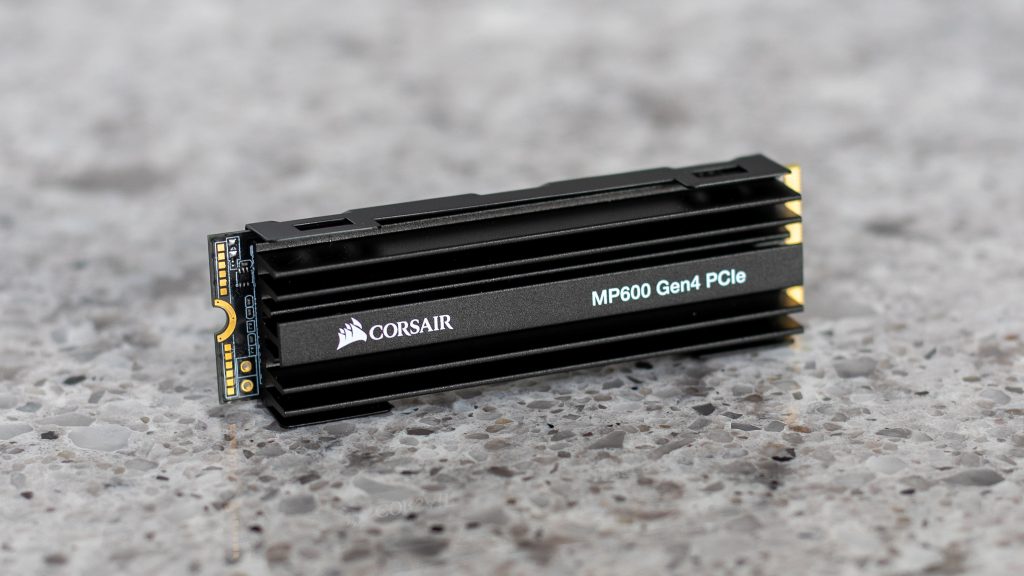It has been a few years now, but thinking back I am sure there are those that remember the hard drive and all that went along with it. Slow start times, heat, noise and an all around much slower PC experience, especially for those that work in media. The largest jump we have seen in storage is without a doubt moving from HDD to SSDs. Specific to SSDs, we have moved from SATA speeds at 540MB/s to PCIe and then to a new NVMe protocol but PCIe still plays a major role in speed. Throughout the years we have seen data transfer speeds progress as PCIe progressed. PCIe 3.0 today is limited to transfer speeds of 3.5GB/s…tops. Our report today will change that with the introduction of the Corsair MP600 MPCIe 4.0 (Gen 4) NVMe SSD.
The Corsair MP600 is the first SSD in the industry to use PCIe 4.0. A heads up though… Such speed comes with a price which starts with an upgrade of equipment. For instance, our testing today is accomplished only through our newest AMD X570 Test Bench which uses the ASRock X570 Creator PCIe 4.0 motherboard and AMD Ryzen 3700x CPU. You are not simply throwing this SSD into any system getting performance of 5GB/s. The system must be PCIe 4.0 compliant.
The Corsair MP600 is a PCIe 4.0 NVMe M.2 SSD and is available in capacities of 500GB, 1TB and 2TB. It’s specifications list performance up to 4950MB/s read, 4250MB/s write with up to 680K IOPS read and 600K IOPS write. Active power consumption is listed at 6.5W and this SSD carries a five year warranty.
In opening the package, you will find the SSD already situated in an aluminum heatsink which can be disassembled as shown here. Such a heatsink is necessary to dissipate the heat created through such high transfer speeds and, at least for the ASRock X570 Creator motherboard, there are two Hyper M.2 Gen 4 slots, both of which have similar cooling solutions integrated into the board and one with a fan for active cooling.
The ONLY company right now that has an available Gen 4 controller is Phison with its PSE5016-E16 controller shown here. The M.2 is a 2280 form factor and contains four pieces of Toshiba BiCS 4 TLC NAND flash memory (two on each side of the SSD), along with a SKHynix DDR4 DRAM cache module.
Pricing of the MP600 is unexpected as one can pick up the 1TB sample we are reviewing today at Amazon for S189 and the 2TB for $372. These are decent prices but remember, that is not including the upgrade of your PC system to accommodate this SSD.
 The SSD Review The Worlds Dedicated SSD Education and Review Resource |
The SSD Review The Worlds Dedicated SSD Education and Review Resource | 


Was the testing done in the CPU native NVMe port or the PCH connected NVMe port?
Kudos… I slipped. Thank you. Will be reposting benchmarks before night end. All but one displayed improvement.
Really what a nice product combination of all aspects required for a small technical component are featured in it in a well defined manner hats off for it.
Review of these devices help to mention their capacity and power to use all the various set of features are discussed and covered under it.
I t will be nice when there are more MPCIe 4.0 (Gen 4) NVMe SSD controllers other than the Phison with its PSE5016-E16. I have a feeling there is much more potential with the Gen 4 SSDs that we will see, hopefully in the very dear future, as everyone should already have their controllers out and being used, as they’ve had more than enough time for product development.
In any case, I’m anxiously awaiting many more reviews of Gen 4 SSDs.
Thanks, Les
I want to use this drive as a Windows boot drive but ALSO run a couple virtual machines on the same drive. Will WIndows performance suffer while the VMs are running?
Can I use this drive in a PCIe Gen3 mobo?
As a PCIe 4.0 SSD, the MP600 delivers incredible storage performance, and is fully backwards compatible with current PCIe 3.0 platforms. It is equipped with a high surface area aluminum heatsink, helping to maintain its performance even under heavy load.